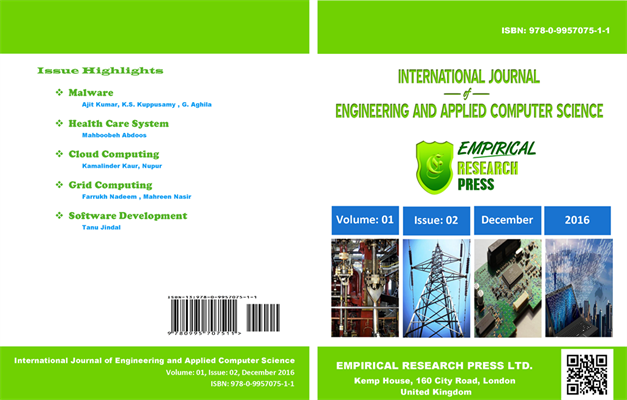



Volume: 01, Issue: 02, December 2016

Content

Ajit Kumar, K.S. Kuppusamy, G. Aghila
h-index
6

i10-index
4
A. Kumar, K. S. Kuppusamy, and G. Aghila, “Features for Detecting Malware on Computing Environments,” International Journal of Engineering and Applied Computer Science, vol. 01, no. 02, pp. 31–36, Dec. 2016. https://doi.org/10.24032/ijeacs/0102/01
Impact Factor
2.35
Abstract—Malware is the main threat for all computing environments. It also acts as launching platform for many other cyber threats. Traditional malware detection system is not able to detect “modern”, “unknown” and “zero-day” malware. Recent developments in computing hardware and machine learning techniques have emerged as alternative solution for malware detection. The efficiency of any machine learning algorithm depends on the features extracted from the dataset. Various types of features are extracted and being researched with machine learning approach to detect malware that are targeted towards computing environments. In this work we have organized and summarized different feature types used to detect malware. This work will direct future researchers and industry to make decision on feature type selection regarding chosen computing environment for building an accurate malware classifier.

Mahboobeh Abdoos

M. Abdoos, “Comparison of Health Care System Architectures,” International Journal of Engineering and Applied Computer Science, vol. 01, no. 02, pp. 37–40, Dec. 2016. https://doi.org/10.24032/ijeacs/0102/02
Abstract—Body area sensor network is an important technology which is suitable for monitoring the patient’s health and real time diagnosing the diseases. The body area network includes the sensors which can be spread over the body or the wearable cloth and a coordinator node which can be a mobile or a tablet or a PDA, which receives the signal of a person’s sensors. In the new architecture the coordinator node sends the information to the central data server via internet or GPRS or MANET. The central data server is responsible for saving and analyzing and representing the received data in the text and graphical mode and sending SMS to the patient’s family or the nearest ambulance or physician, or the operator can call them. The received information is analyzed by the data mining tools. The necessary information will be sent to the physician’s computer. Every patient has a GPS, and it is supposed that the encryption is used for transferring information. In this paper the new architecture is compared with the traditional one which includes the base station and relay nodes. It is shown that the new architecture has less delay than the traditional one.

Kamalinder Kaur, Nupur

K. Kaur and N. Asstt. Professor, “Understanding the Cloud Computing: A Review,” International Journal of Engineering and Applied Computer Science, vol. 01, no. 02, pp. 41–45, Dec. 2016. https://doi.org/10.24032/ijeacs/0102/03
Abstract—Now a days the work is being done by hiring the space and resources from the cloud providers in order to do work effectively and less costly. This paper describes the cloud, its challenges, evolution, attacks along with the approaches required to handle data on cloud. The practice of using a network of remote servers hosted on the Internet to store, manage, and process data, rather than a local server or a personal computer. The need of this review paper is to provide the awareness of the current emerging technology which saves the cost of users.

Mahreen Nasir, Farrukh Nadeem

M. Nasir and F. Nadeem, “Resource Availability Prediction in the Grid: Taxonomy and Review of State of the Art,” International Journal of Engineering and Applied Computer Science, vol. 01, no. 02, pp. 46–53, Dec. 2016. https://doi.org/10.24032/ijeacs/0102/04
Abstract—Use of Grid Computing for carrying out cooperative work from distributed resources has been into practice for the past several years. Efficient execution of various tasks on the grid comes with various challenges. One of them is to ensure that a particular resource remains available during the execution of task. The dynamic nature of resources makes it even more challenging to predict resource availability for complete task duration. This paper is an attempt to address this issue by providing a comprehensive review of the existing methods along with a stated taxonomy of the approaches used.

Tanu Jindal

T. Jindal, “Importance of Testing in SDLC,” International Journal of Engineering and Applied Computer Science, vol. 01, no. 02, pp. 54–56, Dec. 2016. https://doi.org/10.24032/ijeacs/0102/05
Abstract—From previous year researches, it is concluded that testing is playing a vital role in the development of the software product. As, software testing is a single approach to assure the quality of the software so most of the development efforts are put on the software testing. But software testing is an expensive process and consumes a lot of time. So, testing should be start as early as possible in the development to control the money and time problems. Even, testing should be performed at every step in the software development life cycle (SDLC) which is a structured approach used in the development of the software product. Software testing is a tradeoff between budget, time and quality. Now a day, testing becomes a very important activity in terms of exposure, security, performance and usability. Hence, software testing faces a collection of challenges.










